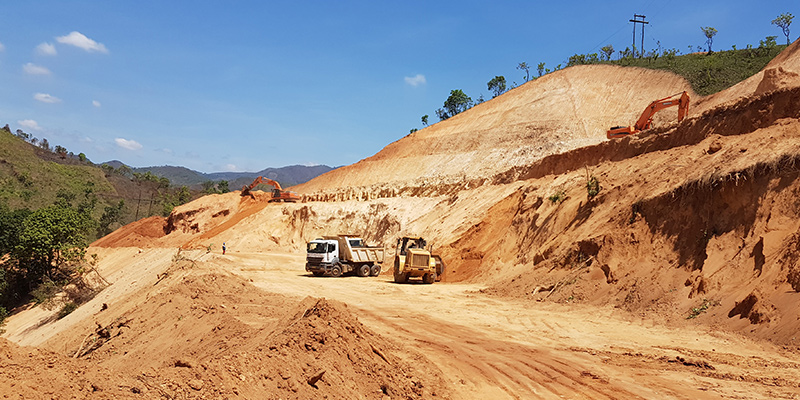Vision 2030 promises to transform Kenya into an industrialised middle-income country and, to that end, proposes ambitious projects which include the Standard Gauge Railway (SGR), the Lamu Port-South Sudan-Ethiopia Transport Corridor (LAPSSET), multipurpose dams and the development of oil and other mineral resources among others.
Large-scale projects, including mining projects, catalyse socio-economic development, which is what many people expect and can easily see. On the other hand, they undermine human rights, cause livelihood disruptions and break up the social fabric of the affected communities. This article focuses on this second aspect and examines compensation and resettlement policy gaps and challenges with respect to the mining sector in Kenya.
Large-scale mining projects lead to involuntary displacement, deprive those affected of the use or access to their resources, disrupt sources of livelihood and interfere with the cultural fabric of the affected communities. International safeguards developed by the World Bank and the Africa Development Bank on involuntary displacement recommend that all community concerns must be taken seriously in the planning and implementation of all investment projects.
World Bank guidelines provide that involuntary resettlement should be avoided and where it is unavoidable, all the people affected must be fully and fairly compensated. Moreover, compensation and resettlement should be seen as an opportunity to improve the livelihoods of those affected. However, the legislation currently guiding compensation and resettlement in Kenya does not regulate these processes in a clear and specific manner.
Take for instance the story of Phase 2A of the Standard Gauge Railway (SGR) that runs from Nairobi to Naivasha traversing Nairobi, Kajiado, Kiambu, Nakuru and Narok Counties, a project which was delayed for three years due to land acquisition and compensation issues.
In the June 22 2019 edition, The East African published stories of human suffering caused by the project. A mother of three, Ms Kusero was promised Sh2 million for her quarter-acre property but a house made of recycled oil drums is all she received as compensation for allowing the SGR to run through her land. Hers was one of many such stories of families whose land was compulsorily acquired for the project. On paper, they were paid billions in compensation but in reality, only a few actually received compensation.
Ms Kusero says that for people like her there were no negotiations and raising grievances regarding compensation was extremely frustrating. “You go to the National Land Commission and you are asked to go to the Ethics and Anti-Corruption Commission. Then you are sent to the Directorate of Criminal Investigation and Director of Public Prosecutions before being bounced back to the National Land Commission. In the end you get frustrated without redress.”
The second story is about the extractives sector and concerns compensation owed by the Kenya Fluorspar Company to the Kimwarer Community in Kerio Valley. After exploration and confirmation of the existence of viable fluorspar, the company excised land and started its mining operations before it had compensated and resettled those it had displaced. There were no consultations whatsoever regarding compensation.
A task force report on the Review of Fluorspar Mining in Kerio Valley established that some attempts at compensation were made. In 1982, two cheques of Sh3,606,000 and Sh500,000 were released by the National Treasury to the District Commissioner to compensate the affected residents. The land compensation value was determined at Sh450 per acre of which Sh50 was deducted directly by the District Commissioner as contribution to a local school fundraiser in the Kimwarer area.
The affected residents who wanted alternative land in compensation were promised they would be resettled on Kilima I and II and Grosell farms in Uasin Gishu. They were also promised that they would receive shares in the Flourspar Company and in the Wagon Hotel in Eldoret town. Those among them who attempted to settle in the promised land were later evicted and accused of invading private property. To date, the victims of these atrocities have not received justice.
Gaps and challenges in the policy and legislative frameworks
Large-scale mining operations require massive tracts of land and often lead to significant human rights violations. Communities whose livelihoods depend on land find themselves in a struggle to defend their rights against the mineral rights granted to investors who are usually large-scale multinationals acting with the full support of host governments.
Kenya’s constitution sets out the general principles of equitable, sustainable and efficient use of land and establishes forms of land ownership. It vests ownership of mineral resources in the government, which means that any land with mineral resources can be compulsorily acquired in the public interest. It further protects the right to property from unlawful deprivation of ownership or limitation of enjoyment unless for public purposes or in the public interest in which case prompt, just and full compensation is required. It is from these provisions that mineral resource projects draw justification to cause involuntary displacement.
Kenya passed a new Mining Act in May 2016 to bolster the legal regime and reinvigorate the mining sector. The Act provides that where a mineral right disturbs or deprives access to the landowner, causes damage to property or occasions loss of earnings, the landowner may claim compensation whose payment must be prompt, adequate and fair. It doesn’t define what “prompt”, “full” and “just compensation” mean. The mineral rights holder is responsible for all the compensation and resettlement costs.
Moreover, the Mining Act appears to overlook the sensitivity of cultural resources. It does not protect or seek to identify cultural assets. Instead, it provides that no demand or claim for compensation shall be made for any loss or damage for which compensation cannot be assessed according to legal principles. Cultural resources are sensitive owing to the level of emotional reaction they spark when interfered with. They include spiritual sites, shrines, medicinal plants and graves whose value cannot be determined using formal processes but only through consultations and negotiations in good faith. The World Bank’s cultural safeguards on involuntary displacement provide that cultural property should be identified, protected and appropriate actions taken to avoid or mitigate adverse impacts, and that interference with cultural assets may only be justified when the loss or damage is agreed to be unavoidable.
The Land Act empowers the National Land Commission on all matters related to compensation. The Commission has the responsibility to make inquiries and determine interests in the land, receive claims of compensation and facilitate just compensation. It does this on request from agencies seeking to compulsorily acquire land. From 2013 to 2019, the Commission paid-out Sh38.273 billion in compensation of which 75.2 per cent went to the SGR and road projects. Within the same period, neither land acquisition nor compensation was undertaken by the Commission for mining-related projects, which raises the question as to how land acquisitions and compensation for extractives are carried out.
Parliament passed the Land Value (Amendment) Act In 2019 to address concerns relating to compulsory land acquisition, compensation and resettlement. One of the gains in this law is that it defines “just compensation”, “prompt” and “full”, terms that are used in the Mining Act, the Land Act and in other laws without clarity. Accordingly, “Just compensation” means a form of fair compensation that is assessed and determined on the basis of the criteria set out under the act. “Prompt” means within a reasonable period of time but not more than one year after the Commission has taken possession of the land. “Full” means the restoration of the value of the land, including improvements made on the land at the date of notice of acquisition.
It is to be noted that unlike in the past where the NLC was required to compensate the landowner before taking possession, the Land Value law now allows possession of the land before compensation is paid. This is contrary to the Mining Act which provides for prior payment of compensation. Taking possession before compensation would disadvantage the affected persons and the one-year period set for paying compensation is too long especially for large-scale mining projects that normally deprive the owner of use of property such as farmland, homestead and grazing areas. The World Bank standards require that compensation is paid in full before displacement or restriction of access.
The Land Value law also provides criteria for assessing the value of compulsorily acquired land based on a land value index to be developed by the Land Cabinet Secretary in consultation with county governments and approved by the National Assembly and the Senate. Assessing land value for compensation purposes requires wide consultations with the affected persons and the relevant agencies, which this Act does not seem to embrace. As provided for, the development of a land value index excludes the participation of the National Land Commission, land valuation agencies such as Surveyors of Kenya, government ministries such as the Ministry of Petroleum and Mining whose main work causes involuntary displacement.
Key issues and action required
The first issue is the fragmentation of the legal frameworks that guide compensation and resettlement in Kenya. The country lacks a national compensation and resettlement policy that standardises compensation and resettlement and ensures that all socio-economic and cultural issues arising from involuntary displacement are properly addressed. The national policy framework on compensation and resettlement should be developed taking into consideration international best practices and safeguards to provide a harmonised policy direction that considers all the complexities that come with involuntary displacement. The policy framework should broadly articulate compensation and resettlement in such a way that it is understood to be an opportunity for improving the livelihoods of the affected people rather than as a process to subjugate them and worsen their livelihoods. At the very least, regulations on compensations and resettlement should be developed for the Mining Act.
The second issue is the uncoordinated institutional approach for compensation matters. The National Land Commission takes charge of both land acquisition and compensation based on requests and funds from the acquiring agencies whose roles are often unclear. The suggested national policy should provide a clear framework for institutional coordination and harmonise the efforts of all relevant agencies; compensation and resettlement must be a multi-agency function. In this way, overlooking community concerns will be minimised and, more importantly, the processes will be more transparent and less fraudulent. Effective institutional coordination will also enable an integrated grievance redress mechanism.
The third issue concerns the land survey regime; it is mired in corruption, inherently opaque and exploitative. Compulsory land acquisition heightens emotions and ignites serious land speculation perpetrated by public officers with privileged information who collude with greedy elites to defraud the state through inflated land prices.
Reforms to introduce transparent land surveying and valuation are required. This means strengthening the policy frameworks and the institutions involved and also requires a robust mechanism for monitoring compulsory acquisition, compensation and resettlement. It should become policy that a compulsory land survey is undertaken prior to the compulsory acquisition of any unregistered land.
The fourth issue is the absence of cultural resources as a factor of compensation and resettlement in the available legislations. Disruption caused by extractive projects on the social, economic and cultural ecosystems of the affected people can never be truly compensated or restored. Compensation merely helps the affected persons to continue with their livelihoods but does not and cannot restore their exact loss.
Legislations guiding compensation should clearly recognise cultural resources and all assets with cultural meaning and value for the affected people as an aspect of the process of negotiating compensation. Effective community participation must be allowed in identifying and deciding the compensation for cultural resources that may be affected by mining projects.
The final issue has to do with the procedures for paying compensation. Where the project affects the whole family, it is unclear whether compensation is awarded to an individual or to a household. Capacity building for the beneficiaries on the use of finances is also a concern and because it is rarely undertaken, waste of compensation funds, family disintegration, homelessness and other socio-economic concerns ensue. Support mechanisms to ensure effective financial planning are therefore important.
The lack of a mechanism to monitor the payment of compensation is another concern, leading to serious irregularities, corruption and human rights violations. Furthermore, the approach to dispute resolution needs to be harmonised to recognise structures at the county level. As they currently stand, the Land Act, the Mining Act and the Land Value Act are inherently contradictory.
–
The article is done with support from Diakonia Kenya Country Office under the Madini Yetu Wajibu Wetu (Our Minerals, Our Responsibility) Project. Views expressed in the article are those of the author.








